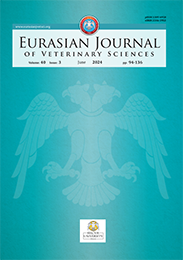| 2021, Cilt 37, Sayı 1, Sayfa(lar) 055-061 |
| [ Türkçe Özet ] [ PDF ] [ Benzer Makaleler ] |
| Diagnosis of feline infectious peritonitis by immunohistochemistry and histopathology methods: A case report based on diagnostic approach |
| Mehmet Burak Ateş, Gökhan Akçakavak, Zeynep Çelik, Özgür Özdemir |
| Selcuk University, Veterinary Faculty, Department of Pathology, Konya, Turkey |
| Keywords: Coronavirus, peritonitis, dry FIP, pyogranuloma, feline |
| Downloaded:830 - Viewed: 2205 |
|
Aim: In this study the case of feline infectious peritonitis (FIP) has
been identified as histopathological and immunohistochemical
(IHC) in a 6-month-old male domestic shorthair cat. In necropsy, the
abdominal cavity contained a significant volume of yellow liquid and
granular fibrinous exudate was seen on the liver, serosa of intestines,
and peritoneum. Microscopically, inflammatory cell infiltration and
fibrin exudation, consisting mainly of macrophage, lymphocyte and
plasma cells, were determined around small and medium-sized vessels
in the tunica serosa layer of the intestines. Many granulomatous
foci of various sizes, with or without necrosis, were found in the liver,
spread to the parenchyma. In methyl green pyronin staining, plasma
cells were found to be the majority of the inflammatory cells present
in lesions. In IHC staining with specific antibodies against the
agent, immunopositivity was obtained in granulomatous lesions in
the serosa layer of the intestines and less frequently in the cytoplasm
of mononuclear cells in the lamina propria. Immunoreactivity was
detected in the cytoplasm of macrophages in the liver, around both
pyrogranulomas and granulomas. It was concluded that this case of
FIP, when all findings are evaluated together, may have started as a
dry form, and turned into a wet form in the terminal period.
|
| [ Türkçe Özet ] [ PDF ] [ Benzer Makaleler ] |





